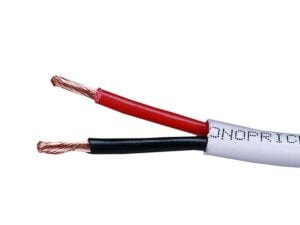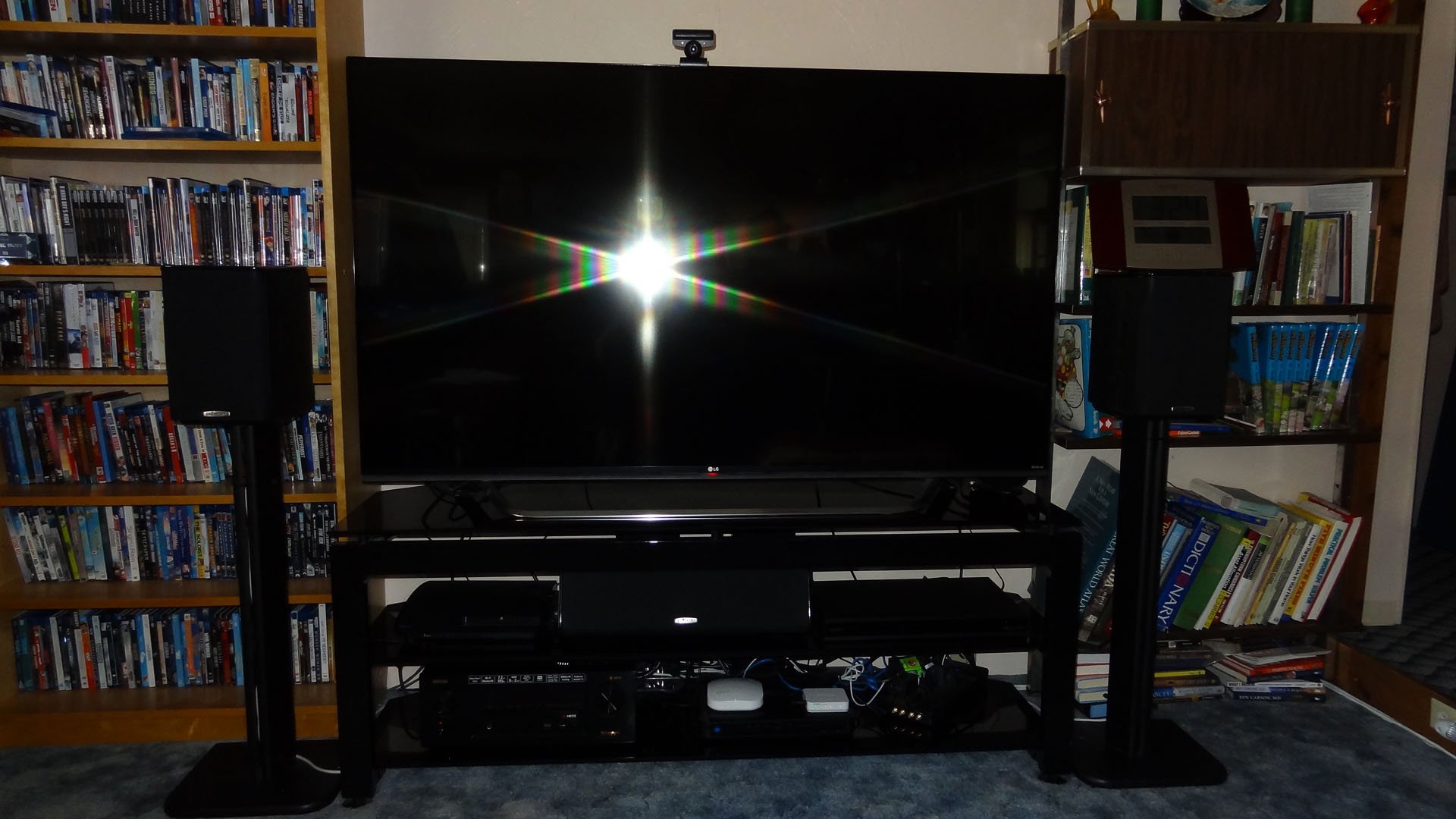Getting started in home theater can be intimidating, scary, and, let’s face it, expensive. It doesn’t have to be. If you’ve always wanted that movie theater experience at home but were afraid the salesman at the big box store or the home consulting/installing service would pull a fast one on you, keep reading, as I’m about to simplify and help you set budgets (and stick to them) and explain the different types of home theater equipment a beginner may consider. I’m going to assume that at the very least you already have:
-
- FHD or UHD display (55-inch or larger)
- Cable or satellite service
Okay, you got the TV home, it’s connected to your cable or satellite service, but the sound from the TV is plain horrible. Well, there is a reason for that. As more and more consumers demanded a TV that appeared more like a picture frame that could be hung on the wall, manufacturers had to figure out a way to include speakers in their TVs. Think of a laptop – most have pretty crummy sound, too, mostly because the manufacturer had to cram two tiny speakers somewhere into the case. Large flat panel displays are no different – chances are the speakers are located along the bottom edge of the bezel, facing downward and are likely powered by a 10-watt amplifier. Sound waves are directional, so rather than having the sound from the TV travel towards you, the sound is traveling down into the floor. Luckily, you have some options, but you need to consider what you want – better sound or a more movie theater experience.
All I want is better sound…
Soundbars
The simplest and often least expensive solution to better sound from your TV is a soundbar. The more basic models are just a thin bar containing two speakers (a left and a right) plus a wireless subwoofer, and can start as low as $100 and can exceed $2,000. A lower-end soundbar is going to give you better sound, usually more amplification, better quality speakers, and a subwoofer to help with bass than what your TV is capable of. And if all you are looking for is better sound, then this is probably the solution for you, although most would not consider this a “home theater.” Soundbars are easy to set up, especially if all you are using is your DVR or converter box and the built-in streaming apps on your TV (for Netflix, Vudu, etc.). Simply connect an optical cable to the optical audio output on your TV to the optical audio input on the soundbar, turn off the built-in speakers in the setting on your TV, select the optical audio selection on the soundbar, and you are good to go. This will give you stereo sound, and some soundbars even include a simulated surround, although your mileage may vary with that feature. In my experience, if you are looking for a soundbar with simulated surround, look for one that has DTS Virtual: X, as that is the only surround simulator I’ve come across that comes close.
2.1, 3.1, 5.1, 7.1 – What do all those numbers mean?
If you’ve been to a big box electronics store and started looking at soundbars, you probably noticed and/or the salesperson probably started throwing these numbers at you like 2.1, 3.1, 5.1, etc. Huh? It may be confusing at first, but it is really rather simple. “2.1” refers to left and right front speakers and a subwoofer. “3.1” refers to a left, center, and right speaker plus a subwoofer. Anything over 3.1 would be surround. He may have even said something like “3.1.2.” In this case, he is referring to spatial audio, either Dolby Atmos or DTS:X, possibly both. The “.2” means two height or reflecting speakers. Some soundbars have multiple little speakers inside, all at varying angles, trying to bounce the sound off the walls in your room. Others have optional add-ons like wireless surround and height speakers. I usually do not recommend going that route, as those add-ons are always proprietary and will only work with that particular make and/or model of soundbar. This means that if a speaker or the soundbar fail, and those are no longer available (which happens quite frequently in home electronics these days), everything must be replaced.
Home Theater in a Box (HTiB)
This is a sector I’m actually happy to see being phased out by most electronics manufacturers. These typically consist of a main unit housing the amplifier, input switcher, and a DVD or Blu-ray player, to which 4 satellite speakers, a center channel speaker, and a subwoofer are then attached (wired, wireless, or a combination of the two). These are self-contained units, and the speakers are usually low-wattage and proprietary. The number of inputs, especially HDMI, are usually extremely limited, often with only one input for your converter box or DVR. While they will still sound better than the built-in speakers on your TV, if one of the speakers go bad or the disc player stops working, the entire set must be replaced.
Soundbars and HTiB’s are better suited for the bedroom, dorm rooms, and playrooms rather than a living room or dedicated home theater room, where space and convenience are more important.
What I really want is sound like at the movie theater
This is where many people get intimidated by complexity and/or cost (and cost can get out of hand pretty quickly if you don’t stay firm from the outset). There are two basic ways you can go here, with both offering the flexibility to easily upgrade as you continue to build your system, and there are some great money-saving tips as well.
When considering a budget, make certain it is attainable and realisitic. I can’t tell you how many times I’ve had someone ask me to help them find a home theater setup, then tell me they only have $200 to spend. $500 is doable, but you will have to make some sacrifices, at least temporarily. $1,000 is a more realistic budget to start with, and will likely include cables. Once you’ve settled on a budget, take an inventory of what you currently have. If starting from scratch, does that include furniture, or in other words, a place to put your receiver, converter box, Blu-ray player, etc.?
Also take into consideration the size and layout of your room. Will you be able to run speaker wire easily? Are there walls or doors preventing you from running wires? Do you have cathedral-style ceilings? If so, are there beams to hang your overhead Atmos speakers from (reflective speakers do not work well with these types of ceilings)? If your room is relatively small, you are likely limited to a 5.1 or 5.1.2 speaker configuration. A comprehensive (and for some, exhaustive) list of speaker setup guides can be found on Dolby’s website. Keep in mind these are recommendations, as not all rooms are created equal, and most receivers include speaker calibration and room correction software to help you achieve the best sound possible (although a few tweaks may be necessary).
For those looking for a “one and done” approach, you may want to consider a receiver/speaker package from Yamaha or Onkyo. These typically sell for under $500, and are entry level receivers paired with decent (not great) satellite speakers and a subwoofer. Something like this will get you up and running with a 5.1 sound system fairly quickly, at a relatively low cost, and the best part is that you can easily upgrade the speakers to better quality ones over time. Should you decide to upgrade the speakers, it is recommended that you replace all fronts and/or all rears with the same manufacturer and series, if possible, so that your speakers are what is referred to as “timber matched,” meaning all of the speakers have a similar tonal quality to them so that as sounds pass from one speaker to the next, there is little to no noticeable change in sound quality. One thing to note about Onkyo – it has been customary for their lowest priced bundle to include a passive rather than active subwoofer. This means that the subwoofer is being powered by the receiver, which reduces amplification power to other speakers. It also makes it more difficult to upgrade later on, especially if you upgrade the receiver, as most home theater receivers only include one or two outputs for an active subwoofer (in other words, a subwoofer with its own built-in amplifier).
If you are wanting better sound from the get go and/or want the flexibility to expand up to 5.1.2 Dolby Atmos or 7.1 surround in the future, then you may want to consider purchasing a higher-end 7.2 receiver and speakers as your budget allows. This will be a more costly approach, but will yield better results to your ears and allow you to more customize your home theater. A good 7.2 receiver will start at around $500 and go up from there. If you shop around, you may be able to find a previous model year receiver on clearance, and that could save you over $100 or more. Here is a little secret about home theater receivers and their manufacturers – much like car manufacturers, receiver manufacturers come out with new models every year, and in most cases the new models have nothing new to offer except maybe a few more watts of power and some minor bells and whistles. You can also look at used or refurbished, but keep in mind these often have no warranty or a 90-day warranty at best, and sometimes the same model can be purchased as new for $20-30 more. If purchasing used or refurbished, make sure it is from a reputable seller with a good return policy (obviously), but also do not purchase any receiver manufactured before 2015, as it will likely not be HDCP 2.2 compliant, meaning it will not be able to pass true UHD video from your UHD Blu-ray player or streaming device, despite claiming to be “4K ready.”
You can then add, as your budget allows, a pair of tower or bookshelf speakers, a center channel, and a subwoofer. At the bare minimum, I would recommend either (1) a pair of tower speakers with good bass response or (2) a pair of bookshelf speakers and a subwoofer, and then build on from there, but make sure the manufacturer makes a matching center channel speaker to add next. In-ceiling speakers are only recommended for Atmos use and not for traditional left, right, center, and surround. Speakers are very subjective from person to person, so it is highly recommended you visit a big box or specialty store to give them a listen to before purchasing, or find an online retailer that has a very flexible and lenient return policy, especially one that doesn’t require you to pay for return shipping. Some receivers, such as those made by Denon and Marantz, now include DTS Virtual:X which offer a virtual surround sound (one of the best I’ve ever heard) from as few as two speakers.
To round out your home theater, you may want to consider a Blu-ray or UHD Blu-ray player. Blu-ray players are usually well-under $100 these days, while a decent UHD Blu-ray player starts at around $250. You can also add a streaming device or two, like a Roku ($30 and up), Fire Stick ($50 and up), or Apple TV ($150 and up).
Lastly and most importantly, don’t forget the cables and surge suppressors. I cannot stress that enough. You will need a high-speed HDMI cable for each device you are connecting to the receiver, plus one high-speed HDMI cable to connect the receiver to the TV. You will also need plenty of speaker wire to connect all of your speakers to the receiver. Personally, I prefer the type of speaker wire that is CL3 rated for in-wall use.

If your speakers are less than 50 feet from the receiver, I’d recommend 16 gauge wire. Otherwise, you may want to consider 14 or 12 gauge instead. If you are connecting a subwoofer, you will need a subwoofer cable, too. There really is no need to spend big bucks for cables, but you also don’t want to go cheap. Monoprice and Amazon are usually good places to find reasonably-priced HDMI, subwoofer, and speaker cables. I will say this, though, about AmazonBasics HDMI cables – I have not had good luck with these cables on runs 10 feet and longer. Remember to use a quality surge suppressor and/or line conditioner to protect your investment but also to keep all those power cords connected to one central spot for easy shut-off in the event of an electrical storm.
Home theater is a fun hobby, and if you start out right, it can bring decades of enjoyment as you upgrade and update your system as both your tastes and technology evolve.
Todd Erwin has been a reviewer at Home Theater Forum since 2008. His love of movies began as a young child, first showing Super 8 movies in his backyard during the summer to friends and neighbors at age 10. He also received his first movie camera that year, a hand-crank Wollensak 8mm with three fixed lenses. In 1980, he graduated to "talkies" with his award-winning short The Ape-Man, followed by the cult favorite The Adventures of Terrific Man two years later. Other films include Myth or Fact: The Talbert Terror and Warren's Revenge (which is currently being restored). In addition to movie reviews, Todd has written many articles for Home Theater Forum centering mostly on streaming as well as an occasional hardware review, is the host of his own video podcast Streaming News & Views on YouTube and is a frequent guest on the Home Theater United podcast.
Post Disclaimer
Some of our content may contain marketing links, which means we will receive a commission for purchases made via those links. In our editorial content, these affiliate links appear automatically, and our editorial teams are not influenced by our affiliate partnerships. We work with several providers (currently Skimlinks and Amazon) to manage our affiliate relationships. You can find out more about their services by visiting their sites.





Similar threads
- DanaRuns
- Beginners, General Questions
3 4 5